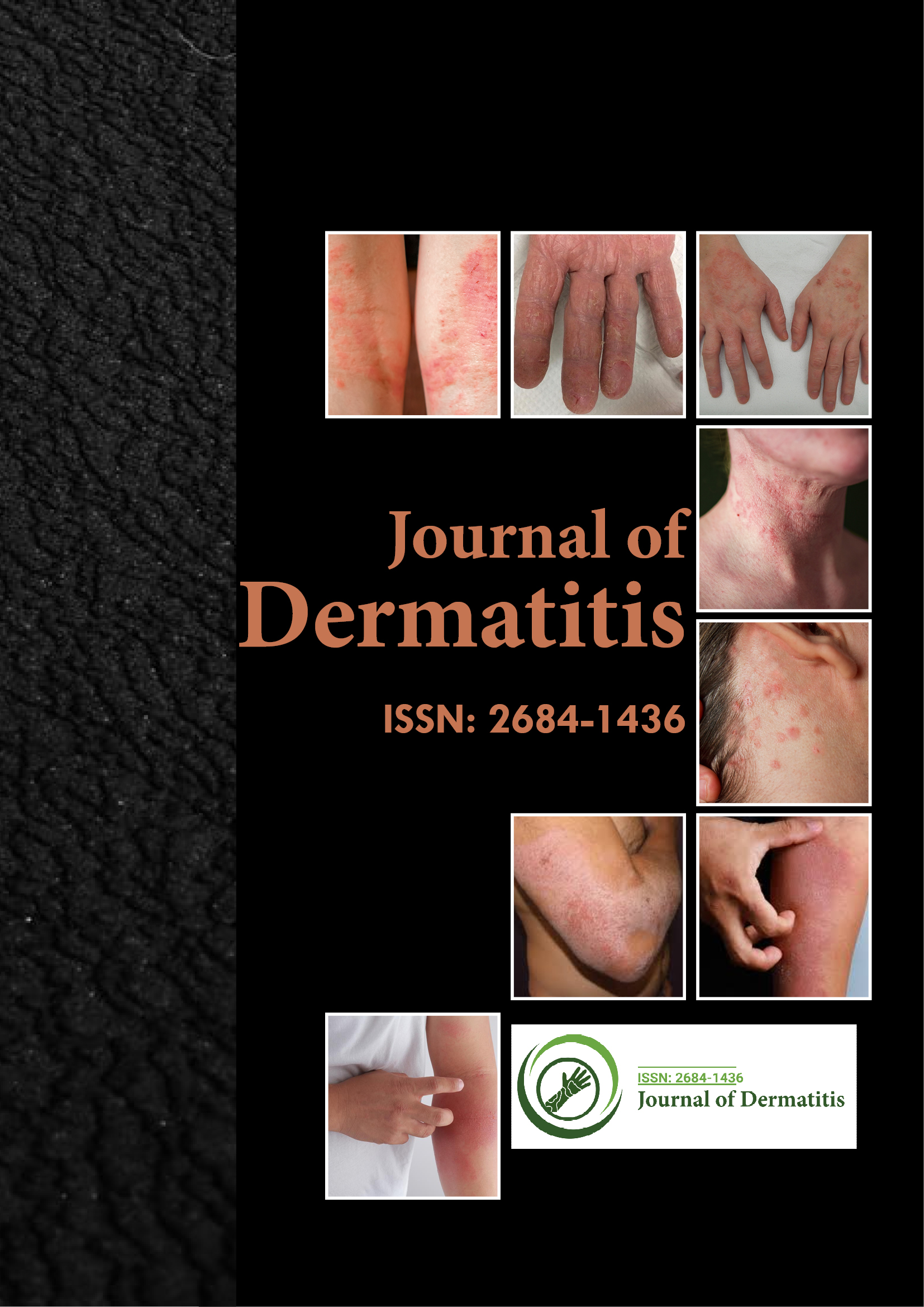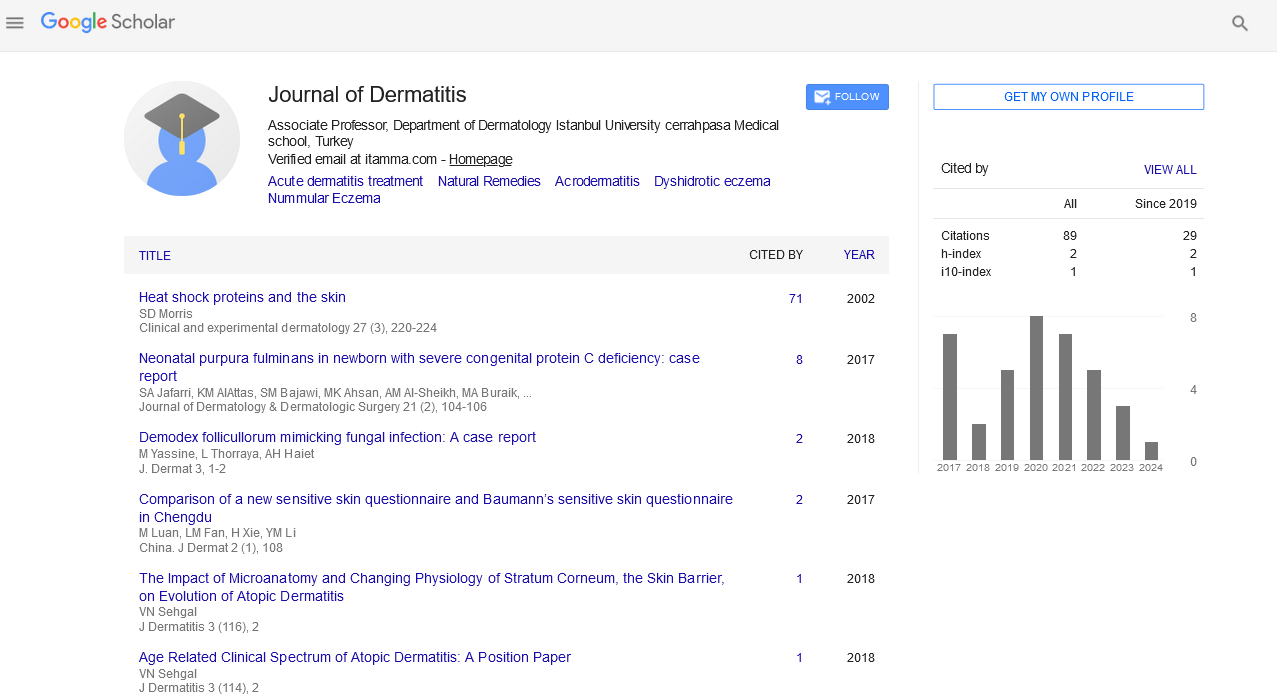Indexed In
- RefSeek
- Hamdard University
- EBSCO A-Z
- Euro Pub
- Google Scholar
Useful Links
Share This Page
Journal Flyer

Open Access Journals
- Agri and Aquaculture
- Biochemistry
- Bioinformatics & Systems Biology
- Business & Management
- Chemistry
- Clinical Sciences
- Engineering
- Food & Nutrition
- General Science
- Genetics & Molecular Biology
- Immunology & Microbiology
- Medical Sciences
- Neuroscience & Psychology
- Nursing & Health Care
- Pharmaceutical Sciences
Commentary - (2025) Volume 10, Issue 2
Environmental Modulators of the Epigenome in Psoriasis Susceptibility
Jing Zhu*Received: 25-Feb-2025, Manuscript No. JOD-25-29125; Editor assigned: 27-Feb-2025, Pre QC No. JOD-25-29125 (PQ); Reviewed: 13-Mar-2025, QC No. JOD-25-29125; Revised: 20-Mar-2025, Manuscript No. JOD-25-29125 (R); Published: 27-Mar-2025, DOI: 10.35248/2684-1436.25.10.280
Description
Psoriasis affects approximately 2%-3% of the global population, with plaque psoriasis being the most prevalent subtype. Clinically, it is characterized by well-demarcated, erythematous plaques covered with silvery-white scales. Despite extensive research into genetic susceptibility loci such as HLA-Cw6, these findings do not fully account for disease variability, suggesting additional layers of regulatory complexity. Epigenetics, which governs gene activity without altering the underlying DNA sequence, is now recognized as an essential component in the pathogenesis of psoriasis.
Epigenetic changes influence immune cell behavior, keratinocyte proliferation and cytokine signaling, all of which are central to disease progression. Moreover, these changes are reversible and modifiable by environmental factors such as diet, stress, infection and medications, making them a potential target for diagnostic and therapeutic innovations.
Epigenetic mechanisms
Epigenetics refers to heritable changes in gene expression that do not involve alterations to the DNA sequence itself. The three principal mechanisms include.
DNA methylation: Addition of a methyl group to cytosine residues in CpG islands, leading to gene silencing or activation depending on the context.
Histone modifications: Post-translational alterations such as acetylation, methylation, phosphorylation and ubiquitination that affect chromatin structure and transcriptional accessibility.
Non-coding RNAs (ncRNAs): Includes microRNAs (miRNAs), long non-coding RNAs (lncRNAs) and circular RNAs that modulate gene expression at the transcriptional and posttranscriptional levels.
Chromatin remodeling
Histone modifications influence gene accessibility by altering chromatin structure. In psoriasis, histone acetylation and methylation have been shown to affect the transcription of inflammatory mediators and keratinocyte proliferation-related genes.
Increased histone H3 lysine 27 acetylation (H3K27ac) is observed in psoriasis lesions and correlates with transcriptionally active enhancer regions in pro-inflammatory genes. Histone Methyltransferases (HMTs) and Histone Deacetylases (HDACs) show altered expression, influencing the balance between active and repressive chromatin states.
Inhibition of HDACs has been tested in preclinical models, demonstrating a reduction in cytokine production and epidermal hyperplasia, further supporting the functional significance of histone changes.
Epigenetic crosstalk with the immune system
The pathogenesis of psoriasis is largely driven by dysregulation in the IL-23/Th17 axis. Epigenetic regulation intersects with these immune pathways by modulating the expression of cytokines and transcription factors.
Th17 cells, which produce IL-17A and IL-22, rely on epigenetic programming to maintain their phenotype. Histone modifications in the promoter, a key transcription factor for Th17 differentiation, influence cell fate decisions.
Regulatory T cells (Tregs) display altered epigenetic profiles in psoriasis, with reduced FOXP3 expression and impaired suppressive function, contributing to chronic inflammation. These findings suggest that the immune imbalance in psoriasis is not solely driven by genetic predisposition but also by epigenetic modifications that affect immune cell plasticity.
Clinical implications
The integration of epigenetic findings into clinical dermatology is still in its early stages, but several potential applications are emerging:
Biomarkers for diagnosis and disease monitoring: Specific miRNA signatures or methylation patterns could aid in distinguishing psoriasis from other dermatoses. Non-invasive sampling, such as skin tape-stripping or blood-based assays, may allow for monitoring disease activity or therapeutic response.
Targets for novel therapeutics: Epigenetic modifiers such as HDAC inhibitors and DNA methyltransferase inhibitors are being investigated for their ability to suppress inflammation and normalize keratinocyte function.
Epigenetic mechanisms contribute significantly to the pathogenesis and variability observed in psoriasis. Through dynamic regulation of gene expression, these modifications influence immune responses, keratinocyte behavior and interaction with environmental stimuli. Understanding these processes provides a valuable layer of insight that complements genetic and clinical data. As research continues, integrating epigenetic markers into diagnostic tools and treatment algorithms may enhance the precision and effectiveness of psoriasis management, supporting a more individualized approach to care.
Citation: Zhu J (2025). Environmental Modulators of the Epigenome in Psoriasis Susceptibility. J Dermatitis. 10:261.
Copyright: © 2025 Zhu J. This is an open-access article distributed under the terms of the Creative Commons Attribution License, which permits unrestricted use, distribution, and reproduction in any medium, provided the original author and source are credited.

